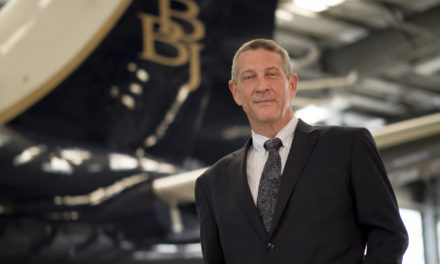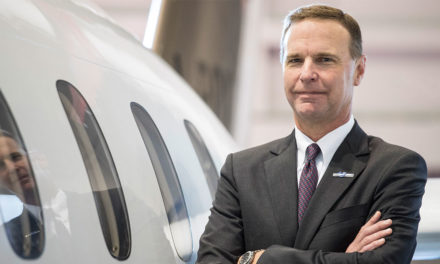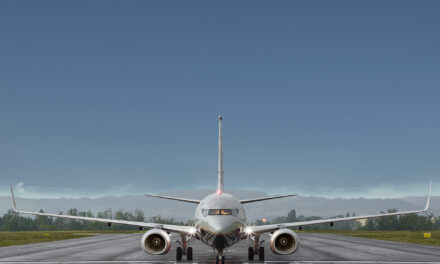For the first time in decades, Dassault Aviation witnessed its military P sector outshine its civil activity. Despite the rough skies experienced by Falcon family, Eric Trappier, CEO of Dassault Aviation still remains confident, expecting a recovery of the business aviation market and above all relying on the strategy that the company has put in place for the future of this business sector.
When the results were announced, you described a sluggish business aviation market faced with numerous geopolitical and economic obstacles. Has business aviation passed its golden age and is it experiencing a profound transformation?
Business aviation is certainly experiencing a transformation. However, I don’t believe that its “golden age” has come and gone, since I think that there will be other prosperous periods for this sector. It is important to note that more and more manufacturers are ahead in shaking up this activity and many of them are releasing new models. This goes to show that we have a future ahead of us in the business aviation sector.
How do you see the future of this industry? Will it be, in time, radically different from what we know today, both in terms of the markets and how it operates?
I think that the market will evolve with the increasing number of users. Despite the hyperconnectivity that we know today and that can be found through our IT devices, an undeniable need remains for efficient travel, which business aviation can offer. In terms of changes to how the business operates, we can already predict that there will be numerous models, not only to buy an aircraft, but ways to access this aircraft. I think that the next few years will be critical for this sector and that we need to support this transformation.
Along with the state of the market, you raise an important matter, that of pre-owned aircraft sales. What is the state of this market and what influence does it actually have on the sale of your aircraft?
It is very simple, the comparison can be made using the system of used price guidelines just like in the car industry. The exact same principle applies in business aviation. Today, the price of business jets on the pre-owned market is falling, because sales in general, and in particular in this sector, are stagnant. If you want to sell your aircraft and its list price is below the “Blue Book” estimations, you are required to sell your aircraft for less and therefore potentially put more money into buying a new aircraft. This situation results in many owners delaying the purchase of a new aircraft. Today, we see owners keeping their aircraft on average one or two years longer while waiting for the market to recover. This has a major impact not only on us but on all manufacturers, because this situation affects us directly in the sale of new aircraft.
Accordingly, does this situation force you to review the sale prices of your aircraft?
This situation effectively generates a price war between aircraft manufacturers. However, if we lower our prices too much, this will have a resulting impact on the margin and we will not be able to reinvest in new programs. If we cannot develop new programs, we will not be able to prepare for the future and continue the legacy of this industry. Once again, lower prices have a limit, even if this obliges us to become more efficient and more competitive. With this in mind, Dassault Aviation has undertaken this transformation that will enable us to have more efficient production and development models.
Can you tell us a little more on this subject?
As I previously stated when the results were announced, this transformation within the group must first ensure that the passion for aviation is upheld. It is this passion that leads to innovation. This transformation will also be digital with increased digital technology in the production facilities using 3D mockups that we have already completed in our design offices. Digital technology will enable us to greatly improve the efficiency of our production management and labor costs which are slightly higher in France than elsewhere. We must remain competitive compared with our competitors. The goal is to bring about an efficiency culture through tools as well as organizational changes. This transformation which we have currently been undergoing over the past year, should help us win, I hope, the battle for competitiveness in the coming 10 years.
Have the initiatives undertaken by China in recent months to reduce its debt caused you to reconsider your market forecasts in this country?
We believe that this market is increasingly active due to the major industries based in China, as well as the fact that the Chinese people are major consumers. We believe, by discussing with them, that there is truly a need for business aviation in China, even though it already has a large fleet. While the market has been slightly disappointing following the economic hurdles that slowed the country’s economic progress over the past two to three years, we need to remain patient with this part of the world, since China is continuously transforming itself. It remains a country that is potentially very rich and economically very developed, and commercially very aggressive. There is therefore no reason that business aviation won’t grow, since from an industry standpoint, Chinese business leaders will also have to travel and save time. I therefore remain very optimistic about this part of the world. Although, I cannot say whether the Chinese economy will recover in the short term, we are still expecting to do many things in and with this country.
What about India for this segment?
Despite the competition between China and India as two great powers, Chinese and Indian dynamics are quite different. Until now, India has always been satisfied with its domestic market. Nevertheless, there remains a major need to travel, although to a lesser extent than in China. This finding may change with the current government that has implied the need to open and conquer international markets. India should develop little by little even if this will take longer than China. However we have an advantage in this market, since we are already very active in the country through our military activities that we plan to capitalize on in order to expand our civil segment.
You mentioned your presence through the military market in India, as well as in certain other countries. Have the recent international sales of Rafales had a direct or indirect impact on Falcon sales?
There is absolutely no impact from military sales on Falcon sales, as they are very different cycles and markets. We clearly have this momentum to take on the civil and military front, not only from the design office, but also in terms of industrialization. This enables us to balance our work load. Nevertheless, as regards the markets, they are both extremely different. The fact that today we have a military activity that is more active than the civil sector is just a matter of cycles. What matters is that there are no cycles where everything goes wrong. The objective today is to prepare for the recovery of Falcon sales. I am convinced that the market will take off again and that our family is capable of supporting this recovery.
Since 2015, the ultra-long range jet segment has been plagued by market instability. What has the impact been on your family and do you think this aircraft segment will continue to dominate the market in spite of it all?
I do believe that this segment will continue to grow. For example, I see how well the Falcon 8X was received, which is currently our ultra-long range jet, following the legacy of the 7X. If I also use the example of our competitors’ long-range jets, we can see that they continue to design products for this segment and that there is customer demand to buy them. As for me, I believe that our long-range segment basically starts at our entry-level, the Falcon 2000. This aircraft is considered to be a high-end aircraft in the mid-size segment. I therefore honestly believe that there is no limit for the future of these aircraft. Meanwhile, the market is demanding greater performance in terms to flight range, silence, fuel efficiency, etc. which requires us to continually develop new technology to improve our aircraft. We are therefore not at the end of the cycle, even though, it must be said the market is sluggish due to the various crises that have successively followed one another, and a pre-owned market that remains overly abundant. We have the advantage of being financially stable, thanks to our civil-military dual aspect that allows us to continually plan for the future, regardless of the current circumstances. This independence helps us to always keep an eye on preparing for the future. This does not mean, on the contrary, that it is not necessary to anticipate major changes that enable us to remain competitive tomorrow.
In terms of the future, you stated, as a conclusion, regarding the Falcon family, the “launch of a new Falcon program” by the end of the year. Can you tell us a little more?
It is firstly an internal launch in order to make the major marketing and technology choices to provide us with real insight on the most adapted product. As such, we will present the aircraft a little later, because we have not yet decided when we want to make an announcement on the market, which would only tip off our competitors too soon.
As regards the delay on the Falcon 5X program, what are the consequences on the industrial level and your teams?
We cannot say that we are happy about this delay and the impact is effectively major, since it is a little over four years in terms of the engines. This has forced us to revise our schedule, that we developed last year on the basis of the schedule for modifications of Snecma’s issues, to compress our development plan in order to make up the time. The challenge lies in the change of the planned pace. It is for this reason that we have slowed the development of self-financing in 2016, rightly in order to not spend too much in this waiting period before approving the effort needed when the engine is ready, especially for speeding up the test flights. The year 2017 will be critical for us. We have to be sure that the engine manufacturer will have properly corrected the problems encountered and that the engines that we receive are up to our standards and our needs. Snecma committed to a modification plan and they are validating it. We are expecting all of these changes to be fully integrated in the same engine and that the Silvercrest delivered to us is ultimately compliant with our requirements for the beginning of 2018, as stated in the schedule that was provided to us. This will enable us to deliver our first aircraft in 2020.
In light of the difficulties encountered by Safran, have you considered giving up on the Silvercrest and turning towards another engine maker?
We have never really considered giving up, despite times of considerable concern, especially when all the problems arose. We have worked closely with Snecma in order to verify that the engine maker had properly identified the problems. Once again, 2017 is a pivotal year for us, as well as for them to the extent that they have to show us that their engine will comply with what we expect from a first series engine.
By Frédéric Vergnères
Copyright : Dassault Aviation – A. Daste
• Dassault Aviation
• Dassault Aviation – E. Franceschi
• Dassault Aviation – S. Randé
• Dassault Aviation – A. Daste
• Dassault Aviation – E. de Malglaive
• Dassault Aviation – V. Almansa
• Dassault Aviation – A. Daste
• Dassault Aviation – S. Randé
• Dassault Aviation – S. Randé
• Dassault Aviation – Droits Réservés
• Dassault Aviation – V. Almansa
• Dassault Aviation – A. Pecchi
• Dassault Aviation – A. Daste
• Dassault Aviation – A. Taiba









